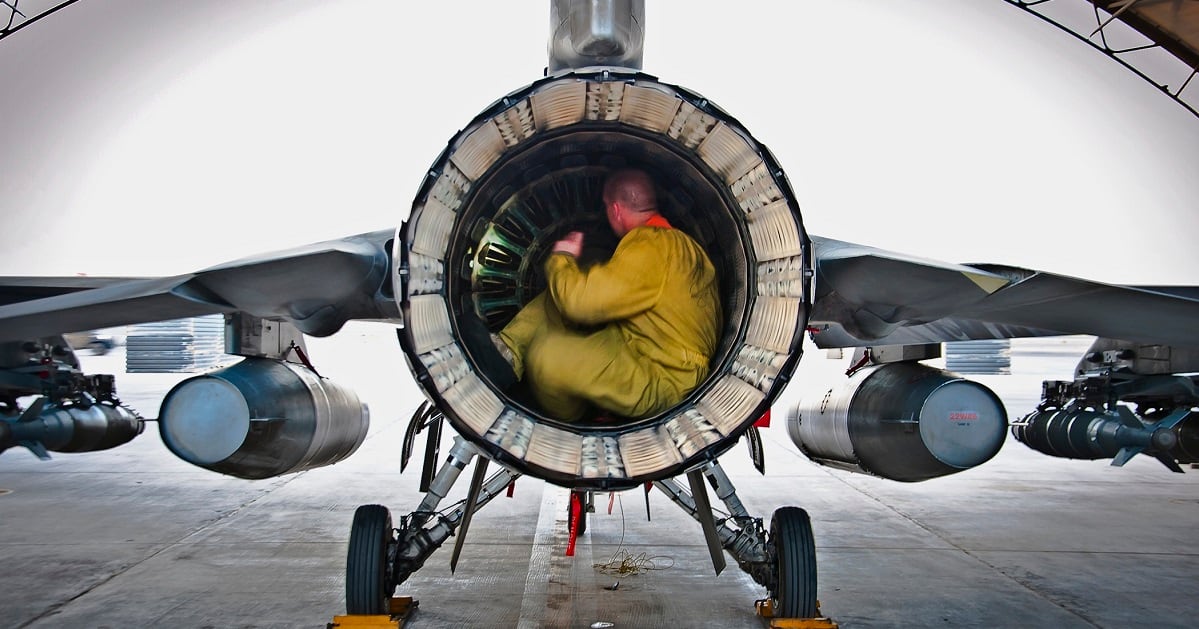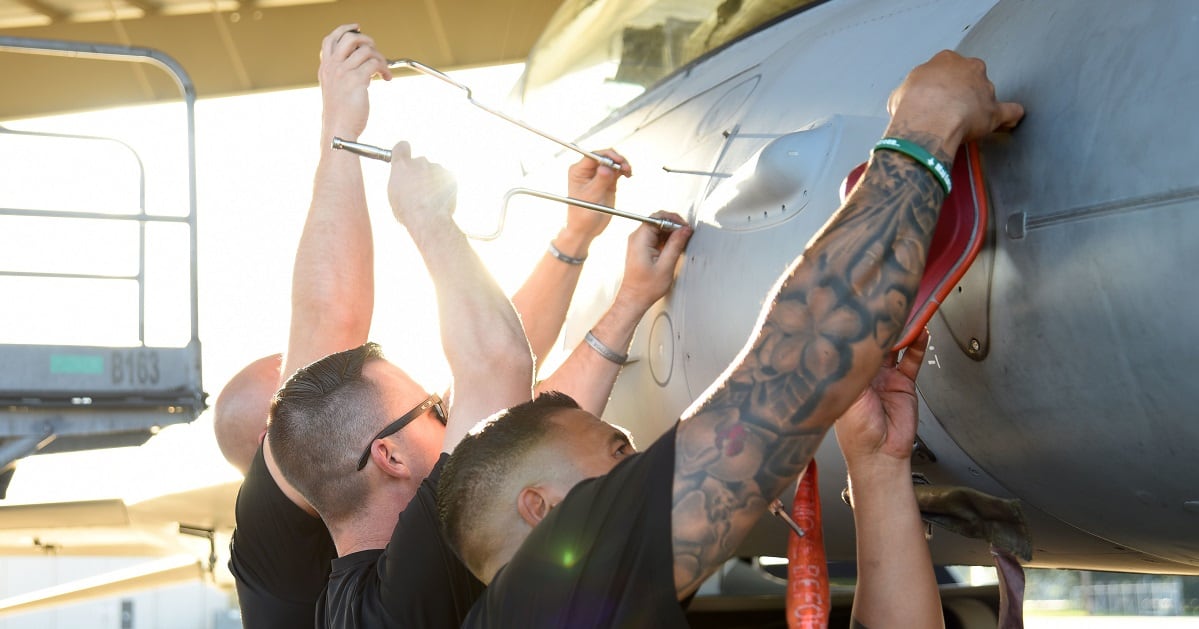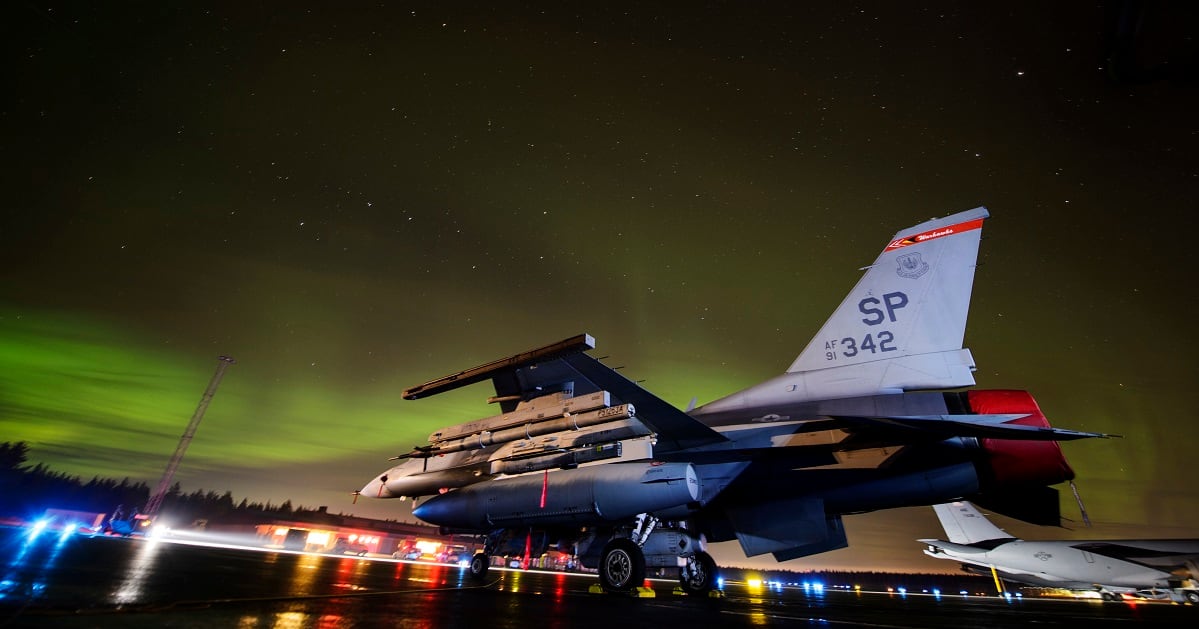Defense Secretary Jim Mattis has thrown down the gauntlet for the Air Force’s maintainers: Get four out of every five F-16, F-22 and F-35 fighter jets ready to fly at any given time — and get it done by the end of fiscal 2019.
It’s not going to be easy — and not only because those planes aren’t anywhere near the 80 percent goal.
Maintainers are already working long hours, with 12-hour-plus shifts and weekend work a common reality on the flightline. Some are bracing themselves for even longer workweeks as the pressure grows to hit that target — but wonder how much more they can give.
“Maintainers have been running hard for a long time,” said retired Gen. Hawk Carlisle, former head of Air Combat Command, in a Nov. 29 interview. “You can only get so much blood from a stone.”
Complicating matters is the fact that F-16s are aging, and require more work. Bases are often short crucial parts necessary to get jets back in the air. And while a massive shortfall in the Air Force’s maintenance ranks has been closed, many of those new, young maintainers are still gaining the vital experience they need to make more advanced repairs and work on their own.
A ‘stretch goal’
One maintainer, who works on F-16’s electrical and environmental systems at Kunsan Air Base in South Korea, said the 80 percent order is “borderline unattainable,” at least in that time frame. Eventually he thinks F-16s can get there, but it’ll be hard to keep 80 percent up if operations tempos increase.

“We all just kind of laughed about it,” said the Kunsan maintainer, who asked to remain anonymous because he was not authorized to speak to the press. “That’s always been the unspoken goal for us anyway, 80 percent. That’s always been the warm fuzzy number for everybody.”
Carlisle said Mattis’ challenge is a way to focus the Air Force’s attention on finding ways to address its readiness shortfalls.
But even if it’s not impossible, Carlisle said it’s “a stretch goal — as an understatement.”
To be sure, mission-capable rates are headed in the wrong direction and need to turn around. They’ve been steadily declining across the fleet for years, and things have gotten particularly worrisome for crucial fighter jets.
MISSION-CAPABLE RATES
Mission-capable rates for the three Air Force fighters covered by Secretary of Defense Jim Mattis' readiness order all declined between fiscal 2016 and 2017, the most recent year for which data was available.
| AIRCRAFT | 2017 | 2016 | CHANGE |
|---|---|---|---|
| F-16C Fighting Falcon | 70.2 % | 73.1 % | - 2.9 |
| F-16D Fighting Falcon | 66 % | 69.1 % | - 3.1 |
| F-22 Raptor | 49 % | 60.2 % | - 11.1 |
| F-35 Lightning II | 54.7 % | 64.6 % | - 9.9 |
| Source: Air Force |
The Air Force declined to make any officials available for interviews to describe how the service planned to meet Mattis’ goals, which were laid out in a September memo to service secretaries. Mattis also wants the Navy to get F-18 mission-capable rates to 80 percent.
But in a Nov. 15 panel discussion, Air Force Secretary Heather Wilson said the Air Force was planning to bolster Air National Guard units with either additional Guardsmen or contractors, to allow them to run second maintenance shifts. Many Guard units now do not have second-shift maintainers who can work on planes that come in from an afternoon flight needing repairs, Wilson said, which means they can’t fly the next morning, harming readiness.
Wilson also said the Air Force is particularly concentrating on improving readiness in squadrons that would be called upon if a conflict were to break out with Russia or China. She said the service is making progress, and is 15 percent more ready than it was 15 months ago, with 75 percent of operational units with combat missions ready to fly.
Maintainers are worried
In a Dec. 5 talk hosted by the Mitchell Institute in Arlington, Virginia, Lt. Gen. Mark Kelly, the deputy chief of staff for operations, said the Air Force needs to strike a balance in managing its maintenance manpower. If the Air Force ends up pushing its more experienced maintainers past the point where their fitness and family lives suffer, Kelly said, “we got a problem.”
But at the same time, the service has to get its readiness rates up, as well as training up its thousands of apprentice maintainers until they reach the 5, or journeyman, level and can handle more complex jobs. Kelly said long hours have been a constant reality for maintainers throughout the 32 years he’s been in uniform, “and I’d be remiss to say that’s going to change in the next year."

Some maintainers are worried. The Air Force is pushing to train and qualify more pilots to help plug a roughly 2,000-pilot gap. And an F-15 avionics airman, who also asked for his name not to be printed, said that means more flying, which will mean more wear and tear on planes that needs to be repaired.
And he fears that’s going to make it even harder for squadrons to hit 80 percent.
“Most bases are already working longer hours and pulling weekend duties,” he said. “That’s kind of the culture. We’re already working pretty hard. … My biggest concern is, for some units, they are going to be flying a lot more to qualify pilots. So that means we’re going to be breaking a lot more planes, and that’s going to put a higher demand on maintainers to try to keep them at 80 percent.”
Current and former maintainers tell Air Force Times they’re stretched thin, sometimes barely having enough time to wolf down a quick lunch before getting back to work. Many get up early to squeeze in their physical fitness training before their shifts begin, they say — no exercising on the job for them.
Retired Master Sgt. Chris Linkous, who was an F-16 crew chief before he retired in 2016, worries that overwork may be straining maintainers and their families.
“There’s just no time,” Linkous said. “These kids are either going to the gym … before they come in to work at 6 in the morning, or they’re going to the gym at 6 in the afternoon when they get off work. There is no time for a family life, there’s no time for anything other than aircraft maintenance.”
Prioritizing the flightline
Career development needs sometimes pull non-commissioned officers away from the flightline — even for things that have nothing to do with fixing planes. Linkous said NCOs often feel compelled to do additional duties like sitting on a 5/6 Council or other NCO organization. This may look good to senior leaders, but it takes them away from the flightline — and the crew chief who keeps turning wrenches and doesn’t play that game could get overlooked come promotion time.
“If you promote the people who are leaving the flightline, then you’re promoting the wrong person, if you want to maintain an 80 percent [mission-capable] rate,” Linkous said. “If you got to leave the flightline several times a day to go to a meeting or go to some council, then you’re doing what you need to do to make yourself look good in the eyes of senior leadership. But you’re not the one that’s carrying the burden of keeping the aircraft flying.”

Carlisle said Air Force commanders will need to take a hard look — as he did when he ran ACC — at where they have every last airman qualified to do maintenance. And if they’re doing other jobs, like office work, Carlisle said they need to be put back on the flightline, where they can do the most good.
Experienced, senior maintainers need to be spread out throughout all three shifts, so they’re not just working day shifts, Carlisle said.
And maintainers need to be recognized for promotion, he said, even — or especially — if they’re out on the flightline every day.
“I don’t need folks double or triple billeted in their position, because it helps them for promotion, and they end up in an office instead of out on the flightline, fixing airplanes,” Carlisle said. “Sometimes being the exec for the wing commander, or the maintenance group commander is a great deal for a maintainer, because it helps his EPRs. My point would be, he can get a great EPR if he’s out there fixing airplanes, so that’s where he should be, not in an office.”
Paying for past mistakes
Carlisle said a lot of the Air Force’s current woes stem from the sequestration-driven drawdown of 2014, which blasted a hole in the maintenance ranks. It was a mistake, Carlisle said, and he acknowledged he bears some of the responsibility for that.
The Kunsan maintainer also feels the drawdown contributed to the problem.
Almost immediately after it was completed, service officials started grumbling the Air Force was short 4,000 maintainers of what it needed to carry out all its missions,. It has now all but closed that gap, but with young maintainers who still need to gain years of experience.
The new electrical and environmental systems airmen coming to Kunsan are capable. But some previously worked on other air frames, and it takes time to get up to speed on the finer points of the F-16.
The Fighting Falcon’s age presents another challenge. In 2017, the average F-16 was roughly 27 years old. And the Kunsan maintainer said that any wiring — especially in parts that haven’t seen the light of day since the 80s or 90s — will grow old and brittle and wear out. This requires a lot of knowledge to troubleshoot where the shorts are coming from, root out which small wire is the culprit, and replace it.
Parts shortages also makes keeping older aircraft flying tricky, the Kunsan maintainer said, especially when manufacturers go out of business or stop making a particular item. For example, the Air Force is running low on a particular low-stage valve after it had to re-bid a contract for them, he said. Kunsan is cannibalizing other F-16s and juggling parts around — “robbing Peter to pay Paul,” the maintainer said — but there are still four F-16s on the ground there because they lack that valve. Two more F-16s also lack the valve, he said, but also have other issues that have landed them in the depot.

Wilson noted that the Air Force is working to improve the flow of spare parts to the field, which is another major factor keeping planes on the ground, and is also using more 3-D printing.
“When an aircraft is down for maintenance, sometimes it’s not about the maintenance itself, it’s about you waiting for the part to come in,” she said.
The Air Force will also make greater use of conditions-based maintenance — or tracking and predicting when parts are likely to fail and catching them before they break, she said.
If squadron maintainers can tell a part is on the verge of failing in advance, they can plan to swap it out during an already-scheduled repair job, said retired Col. Pat Kumashiro, who served as the chief of the service’s maintenance division from 2012 to 2016. That’s when they’ve already got the hood up, so to speak. But if a part fails without warning, the pilot could be put at risk, and the plane could be out of commission for a longer period of time, further depressing readiness rates.
Airlines have been doing such predictive maintenance for years, said Heritage Foundation fellow and former F-16 pilot John Venable — and they’re very good at it.
Mattis is right to demand the services reach mission-capable rates of 80 percent, he said. The Air Force would never get past the current “laissez-faire style” of maintenance expectations if Mattis didn’t put it on the table.
“This is a huge marker, and we need to step up to that line,” he said. “I believe it’s realistic, and I believe it’s going to take a Herculean effort to get there.”
The manpower is there, Venable said, even if the skill levels aren’t properly balanced. They’re going to have to work longer hours, he acknowledged.
Burnout is always a risk, Carlisle said. But he and Venable agree that leaders who step up and inspire maintainers to meet that challenge can avoid that problem.
“Leaders have always found a way to do this — when you work harder, together as a team, morale goes up, it doesn’t go down,” Venable said. Leaders should set “big goals, and when you cross them, you celebrate. You have this feeling that you’ve accomplished something, as opposed to going in and punching a card and going back home at the end of an eight-hour day. This is something that leaders do, it’s not something that managers do.”
When Mattis delivers this kind of ambitious goal, he means it, Venable said. The Air Force shouldn’t be satisfied if it makes some progress but falls short — nor should airmen assume Mattis will be placated.
“I’ve never seen Mattis … lead that way,” Venable said. “It’s always been with the expectation that they will come through. … I don’t think any of the services would be wise to think that a good effort, and falling short, is going to satisfy this leader.”
Stephen Losey is the air warfare reporter for Defense News. He previously covered leadership and personnel issues at Air Force Times, and the Pentagon, special operations and air warfare at Military.com. He has traveled to the Middle East to cover U.S. Air Force operations.





